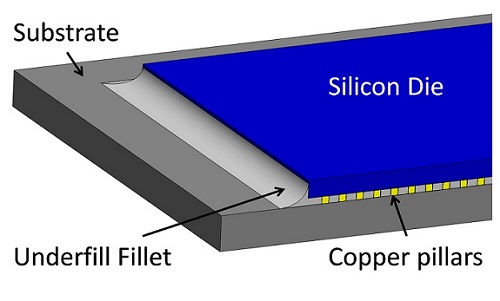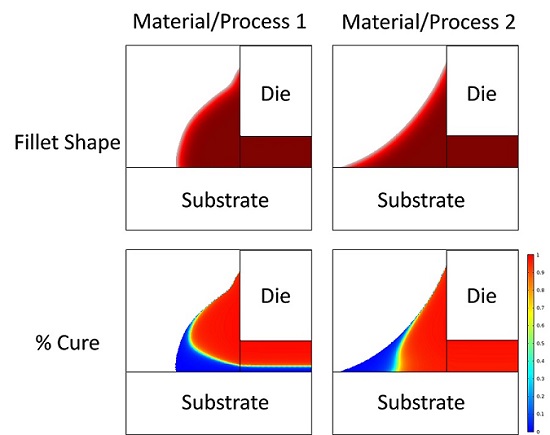Technical Challenge
The microelectronics packaging industry relies heavily on adhesive bonding to assemble electronic components. The demand for higher manufacturing throughput and lower cost means there is a constant need for advances in adhesives and assembly process technology. One emerging adhesives technology is non-conductive film (NCF), which involves application of an underfill to an entire wafer prior to die singulation and thermocompression bonding.
Among the challenges with NCF technology is the need to optimize the adhesive properties and process variables to realize the shortest possible bonding time while, among other factors, creating a properly shaped underfill fillet at the die edge (see Figure 1). A concave fillet shape is critical for device reliability. This optimization is a challenge due to the very short process times, rapid heating rates, and complex chemorheology of NCF materials.
Veryst Solution
Veryst built a COMSOL Multiphysics model of the NCF thermocompression bonding process to help reduce bonding cycle time by simultaneously optimizing both the material and process variables. The model involves multiphase flow, surface wetting, and heat transfer. Additionally, a chemorheology model of the underfill was implemented in COMSOL Multiphysics both to track the evolution of the underfill cure and to account for the impact of degree of cure and temperature on viscosity.
Process variables in the model included the compression and temperature profiles applied to the silicon die and substrate by the bonding tool. Figure 2 shows a representative die temperature profile and how the degree of cure and viscosity of the model underfill evolve during the process.
The predicted underfill fillet shape and degree of cure within the fillet is shown in Figure 3 for two material/process combinations.
The convex fillet shape that develops with material/process 1 is unacceptable as it will lead to reliability issues.
The desired fillet shape was obtained with material/process 2.

